Giro d'Italia
 | |
| Race details | |
|---|---|
| Date | May–June |
| Region | Italy and nearby countries |
| English name | Tour of Italy |
| Local name(s) | Giro d'Italia (Italian) |
| Discipline | Road |
| Competition | UCI World Tour |
| Type | Grand Tour |
| Organiser | RCS Sport |
| Race director | Mauro Vegni |
| History | |
| First edition | 1909 |
| Editions | 99 (as of 2016) |
| First winner |
|
| Most wins |
|
| Most recent |
|
The Giro d'Italia (Italian pronunciation: [ˈdʒiːro diˈtaːlja]; English: Tour of Italy;[1] aka Corsa Rosa[2] or Giro) is an annual multiple-stage bicycle race primarily held in Italy, while also occasionally passing through nearby countries.[3] The race was first organized in 1909 to increase sales of the newspaper La Gazzetta dello Sport;[3][4] however it is currently run by RCS Sport.[5][6] The race has been held annually since its first edition in 1909, except when it was stopped for the two world wars.[3] As the Giro gained prominence and popularity the race was lengthened, and the peloton expanded from primarily Italian participation to riders from all over the world. The Giro is a UCI World Tour event, which means that the teams that compete in the race are mostly UCI Proteams, with the exception of the teams that the organizers can invite.[7][8]
Along with the Tour de France and Vuelta a España, the Giro makes up cycling's prestigious three-week-long Grand Tours.[3][9] The Giro is usually held during late May and early June.[3] While the route changes each year, the format of the race stays the same, with the appearance of at least two time trials, and a passage through the mountains of the Alps,[10] including the Dolomites. Like the other Grand Tours, the modern editions of the Giro d'Italia normally consist of 21 day-long segments (stages) over a 23-day period that includes 2 rest days.[3]
All of the stages are timed to the finish. After finishing the riders' times are compounded with their previous stage times. The rider with the lowest aggregate time is the leader of the race and gets to don the coveted pink jersey.[3][11] While the general classification gathers the most attention there are other contests held within the Giro: the points classification for the sprinters,[11] the mountains classification for the climbers,[11] young rider classification for the riders under the age of 25,[11] and the team classification for the competing teams.[11] Italian rider Vincenzo Nibali was the victor in the 2016 edition of the race.[12]
History

The idea of the holding a bicycle race that navigated around Italy was first suggested when La Gazzetta dello Sport editor Tullo Morgagni sent a telegram to both the paper's owner, Emilio Costamagna, and cycling editor, Armando Cougnet, stating the need for an Italian tour.[13][14] At the time La Gazzetta's rival, Corriere della Sera was planning on holding a bicycle race of its own, after the success they had gained from holding an automobile race.[13][14][15] Morgagni then decided to try and hold their race before Corriere della Sera could hold theirs, but La Gazzetta lacked the money.[14] However, after the success La Gazzetta had with creating the Giro di Lombardia and Milan–San Remo, the owner Costamagna decided to go through with the idea.[14][16] Their bike race was announced on August 7, 1908 in the first page of that day's edition of La Gazzetta dello Sport.[15] The race was to be held in May of 1909.[15] The idea of the race was inspired by the Tour de France and the success that L'Auto had gained from it.[4][16]
Since the organizers lacked the funds, 25,000 lire,[13] needed to hold the race, they consulted Primo Bongrani, an accountant at the bank Cassa di Risparmio and friend of the three organizers. Bongrani proceeded to go around Italy asking for donations to help hold the race.[14] Bongrani's efforts were largely successful, he had procured enough money to cover the operating costs.[14] The money that was to be given out as prizes came from a casino in San Remo after Francesco Sghirla, a former Gazzetta employee, encouraged it to contribute to the race.[13][14] Even Corriere, La Gazzetta's rival, gave 3,000 lire to the race's fund.[13]
On 13 May 1909 at 02:53 am 127 riders started the first Giro d'Italia at Loreto Place in Milan.[4][15] The race was split into eight stages covering 2,448 km (1,521 mi).[15] A total of 49 riders finished, with Italian Luigi Ganna winning.[15][17] Ganna won three individual stages and the General Classification.[17] Ganna received 5325 lira as a winner’s prize, with the last rider in the general classification receiving 300 lira.[15] The Giro's director received only 150 lira a month, 150 lira fewer than the last-placed rider.[15]
The first Giro was won by Luigi Ganna, while Carlo Galetti won the two following Giros. In 1912, there was no individual classification, instead there was only a team classification, which was won by Team Atala. The 1912 Giro is the only time the competition has not had an individual classification.[18] From 1914 onwards the scoring format was changed from a points-based system to a time-based system, in which the cyclist who had the lowest aggregate time at the end of the race would win. The Giro was suspended for four years from 1915 to 1918, due to the First World War. Costante Girardengo was the winner of the first Giro after the war in 1919.[19]
The dominant figure in the 1920s was Alfredo Binda, who won his first Giro in 1925 and followed this up with another victory in 1927, in which he won 12 of the 15 stages. Victory in 1929 came courtesy of eight successive stage wins. At the height of his dominance Binda was called to the head office of La Gazzetta dello Sport in 1930; the newspaper accused him of ruining the race and offered him 22,000 lira to be less dominant, which he refused.[20] Binda won five Giros before he was usurped as the dominant cyclist by Gino Bartali. Nicknamed the "Iron Man of Tuscany" for his endurance, Bartali won two Giros during the 1930s, in 1936 and 1937.[21] Bartali's dominance was challenged in 1940, the last Giro before the Second World War, when he was defeated by his 20-year-old team-mate Fausto Coppi.[22]
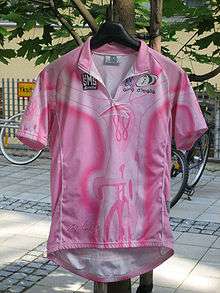
The rivalry between Bartali and Coppi intensified after the war. Bartali won his last Giro in 1946, with Coppi winning his second the following year. Coppi won a further three Giros and in 1952 he became the first cyclist to win the Tour de France and Giro in the same year. Swiss Hugo Koblet became the first non-Italian to win the race in 1950.[23] No one dominated the tour during the 1950s, Coppi, Charly Gaul and Fiorenzo Magni each won two Giros during the decade. The 1960s were similar, five-time Tour de France winner Jacques Anquetil won in 1960, and 1964,[24] while Franco Balmamion won two successive Giros in 1962 and 1963.[25]
Belgian Eddy Merckx was the dominant figure during the 1970s. His first victory came in 1968; another triumph in 1970 was followed by three successive victories from 1972 to 1974, which is the record for the most successive victories in the Giro.[26] Felice Gimondi was victorious in 1976 winning his third Giro. Belgians Michel Pollentier and Johan De Muynck won the two subsequent Giros in 1977 and 1978. In 1980, Frenchman Bernard Hinault who up to this point had won two Tours de France, became France's first winner since Anquetil in 1964. He would win another two Giros in 1982 and 1985.[27]
Stephen Roche was victorious in 1987, a year in which he also won the Tour and the UCI Road World Championship.[28] American Andy Hampsten became the first non-European winner the following year,[23] and Laurent Fignon was victorious in 1989. Spaniard Miguel Indurain, winner of five Tours, won successive Giros in 1991 and 1992. Three time winner of the Vuelta a España, Tony Rominger was victorious in 1995, defeating the previous winner Evgeni Berzin.[29] Marco Pantani was the winner in 1998, a year in which he completed the Tour and Giro double, Ivan Gotti won the previous Giro in 1997 and the subsequent one in 1999.
Stefano Garzelli won the Giro in 2000.[30] Gilberto Simoni was the winner in 2001 and 2003, with Paolo Savoldelli victorious in 2002. Simoni was denied a third victory in 2004, when he was beaten by team-mate Damiano Cunego. Salvodelli won his second Giro in 2005, beating Simoni by 28 seconds. Ivan Basso was the victor in 2006, Danilo di Luca won in 2007, though the tour was marred by doping allegations.[31] Spaniard Alberto Contador of Astana was the winner in 2008; the following year he raced in the Tour de France instead, and Denis Menchov was the Giro victor.[32] Basso returned after a doping suspension to regain his title in 2010.[33] Contador was the victor at the podium ceremony in Milan,[34] but he was later stripped of the title after he was found guilty of doping in the 2010 Tour de France. Runner-up Michele Scarponi was awarded the victory.[35] Ryder Hesjedal became the first Canadian to win the Giro in 2012, beating Joaquim Rodríguez by 16 seconds.[36] After gaining the lead after the eighth stage, Vincenzo Nibali won two more stages to help consolidate his lead and win the 2013 edition.[37]
Classifications
A few riders from each team aim to win overall but there are three further competitions to draw riders of all specialties: points,[11] mountains,[11] and a classification for young riders with general classification aspirations.[11] The oldest of the four classifications is the general classification.[3][11] The leader of each aforementioned classifications wears a distinctive jersey.[11] If a rider leads more than one classification that awards, he wears the jersey of the most prestigious classification.[11] The abandoned jersey is worn by the rider who is second in the competition.[11]
General classification

The most sought after classification in the Giro d'Italia is the general classification.[3] All of the stages are timed to the finish, after finishing the riders' times are compounded with their previous stage times; so the rider with the lowest aggregate time is the leader of the race.[3][11] The leader is determined after each stage's conclusion. The leader of the race also has the privilege to wear the race leader's pink jersey.[3][11] The jersey is presented to the leader rider on a podium in the stage's finishing town. If a rider is leading more than one classification that awards a jersey, he will wear the maglia rosa since the general classification is the most important one in the race. The lead can change after each stage.
The color pink was chosen as the magazine that created the Giro, La Gazzetta dello Sport, printed its newspapers on pink paper.[11][15] The pink jersey was added to the race in the 1931 edition and it has since become a symbol of the Giro d'Italia.[3][15] The first rider to wear the pink jersey was Learco Guerra.[3][15] Each team brings multiple pink jerseys in advance of the Giro in case one of their riders becomes the overall leader of the race. Riders usually try to make the extra effort to keep the jersey for as long as possible in order to get more publicity for the team and the sponsor(s) of the team. Eddy Merckx wore the jersey for 78 stages, more than any other rider in the history of the Giro d'Italia.[38][39][40] Three riders have won the general classification five times in their career: Alfredo Binda, Fausto Coppi, and Eddy Merckx.[41]
The general classification winner was not always determined by a time system. In the inaugural Giro d'Italia the organizers chose to have a points system over a system based around elapsed time after the scandal that engulfed the 1904 Tour de France.[14] In addition to that, the organizers chose the point system since it would be cheaper to count the placings of the riders rather than clocking the riders during each stage.[14] The race leader was calculated by adding up each rider's placings in each stage and the rider with the lowest total was the leader; if a rider placed second in the first stage and third in the second stage, he would have five points total. The system was modified a year later to give the riders who placed 51st or higher in a stage 51 points and keep the point distribution system the same for the riders who placed 1st through 50th in a stage.[42] The calculation remained unmodified until 1912 where the organizers chose to have the race be centered around teams, while still keeping the point system.[43] The next year race organizers chose to revert to the system used in 1911.[43] In 1914, the organizers shifted to the system used nowadays, where riders would have their finishing times for each stage totaled together to determine the overall leader.[44]
These are the time bonuses that the riders receive for crossing the lines in the first few positions:[45]
| Type | 1st | 2nd | 3rd | |
|---|---|---|---|---|
| Flat finish | 10" | 6" | 4" | |
| Intermediate Sprint | 3" | 2" | 1" | |
Mountains classification
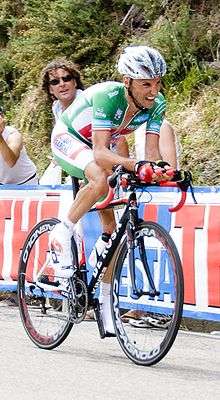
The mountains classification is the second oldest jersey awarding classification in the Giro d'Italia. The mountains classification was added to the Giro d'Italia in 1933 Giro d'Italia and was first won by Alfredo Binda.[15][46] During mountain stages of the race, points are awarded to the rider who is first to reach the top of each significant climb.[15] Points are also awarded for riders who closely follow the leader up each climb.[15] The number of points awarded varies according to the hill classification, which is determined by the steepness and length of the course.[11][15]
The climbers' jersey is worn by the rider who, at the start of each stage, has the largest amount of climbing points.[15] If a rider leads two or more of the categories, the climbers' jersey is worn by the rider in second, or third, place in that contest.[11] At the end of the Giro, the rider holding the most climbing points wins the classification.[11] In fact, some riders, particularly those who are neither sprinters nor particularly good at time-trialing, may attempt only to win this particular competition within the race. The Giro has four categories of mountains. They range from category 4, the easiest, to category 1, the hardest. There is also the Cima Coppi, the highest point reached in a particular Giro, which is worth more points than the race's other first-category climbs.[11] Gino Bartali has won the mountains classification a record seven times.[41]
The classification awarded no jersey to the leader until the 1974 Giro d'Italia, when the organizers decided to award a green jersey to the leader.[15] The green jersey was used until 2012, when the classification's sponsor, Banca Mediolanum, renewed its sponsorship for another four years and desired the jersey to be blue rather than green.[47] Stefano Pirazzi won the mountains classification at the 2013 Giro d'Italia.
The point distribution for the mountains is as follows:[48]
| Type | 1st | 2nd | 3rd | 4th | 5th | 6th | 7th | 8th | 9th | |
|---|---|---|---|---|---|---|---|---|---|---|
| Cima Coppi | 40 | 28 | 21 | 15 | 9 | 5 | 3 | 2 | 1 | |
| First Category | 32 | 20 | 14 | 10 | 7 | 4 | 2 | 1 | ||
| Second Category | 14 | 9 | 6 | 4 | 2 | 1 | ||||
| Third Category | 7 | 4 | 2 | 1 | ||||||
| Fourth Category | 3 | 2 | 1 | |||||||
Points classification

The points classification is the third oldest of the four jersey current awarding classifications in the Giro d'Italia. It was introduced in the 1966 Giro d'Italia and was first won by Gianni Motta.[15][49] Points are given to the rider who is first to reach the end of, or determined places during, any stage of the Giro. The red jersey is worn by the rider who at the start of each stage, has the largest amount of points.[15] The rider whom at the end of the Giro, holds the most points, wins the points competition. Each stage win, regardless of the stage's categorization, awards 25 points, second place is worth 20 points, third 16, fourth 14, fifth 12, sixth 10, and one point less per place down the line, to a single point for fifteenth.[45] This means that a true sprinter might not always win the points classification. The classification was added to draw the participation of the sprinters. The classification has been won four times by two riders: Francesco Moser and Giuseppe Saronni.[41] The 2013 winner of the classification was Mark Cavendish.
In addition, stages can have one or more intermediate sprints: 8, 6, 4, 3, 2, 1 point(s) are/is awarded to the first six cyclists passing these lines.[45] These points also count toward the TV classification (Traguardo Volante, or "flying sprint"), a separate award.[45]
The first year the points classification was used, it had no jersey that was given to the leader of the classification. In the 1967 Giro d'Italia, the red jersey was added for the leader of the classification.[15] However, in 1969 the red jersey was changed to a cyclamen (purple) colored jersey.[11][15] It remained that color until 2010 when the organizers chose to change the jersey back to the color red; in a return to the original color scheme for the three minor classifications, which reflected the colors of the Italian flag.[50]
The point distribution for the sprints are as follows:[45]
| Type | 1st | 2nd | 3rd | 4th | 5th | 6th | 7th | 8th | 9th | 10th | 11th | 12th | 13th | 14th | 15th | |
|---|---|---|---|---|---|---|---|---|---|---|---|---|---|---|---|---|
| Finish/Time Trial | 25 | 20 | 16 | 14 | 12 | 10 | 9 | 8 | 7 | 6 | 5 | 4 | 3 | 2 | 1 | |
| Intermediate sprint | 8 | 6 | 4 | 3 | 2 | 1 | ||||||||||
Young rider classification
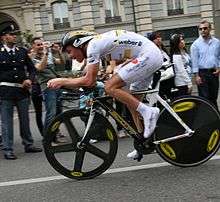
The Young rider classification is restricted to the riders that are under the age of 25.[11][51] The leader of the classification is determined the same way as the general classification, with the riders' times being added up after each stage and the eligible rider with lowest aggregate time is dubbed the leader.[11][51] This classification was added to the Giro d'Italia in the 1976 edition, with Alfio Vandi being the first to win the classification after placing seventh overall.[51] The classification was not contested between the years of 1995 and 2006.[11] The classification was reintroduced in the 2007, and has been in each Giro since.[11][51] The Giro d'Italia awards a white jersey to the leader of the classification.[51] Evgeni Berzin is the only rider in the history of the Giro d'Italia to win the young rider classification and the general classification in the same year; Berzin won both classifications in 1994.[51] Two riders have won the young rider classification twice in their respective careers: Vladimir Poulnikov and Pavel Tonkov.[41] In 2013 it was won by Carlos Betancur.
Team classifications
There are two team classifications that are contested at the Giro d'Italia: the Trofeo Fast Team and the Trofeo Super Team. The Trofeo Fast Team is the older of the two as it was introduced in the first Giro d'Italia. It was first won by Atala. The Trofeo Fast Team is calculate by adding the times of the best three cyclists per team on each stage were added; the leading team was the team with the lowest total time.[11] The classification just called the team classification in each edition until the organizers changed it to the Trofeo Fast Team for the 1994 Giro d'Italia. Team Sky won the Trofeo Fast Team classification in 2013.
The Trofeo Super Team was introduced at the 1993 Giro d'Italia as the team points classification. The name Trofeo Super Team was adopted for the 1994 edition of the Giro and been used ever since. The classification was first won by Ariostea in 1993. The classification is a team points classification, with the top 20 placed riders on each stage earning points (20 for first place, 19 for second place and so on, down to a single point for 20th) for their team.[11] Movistar Team won the Trofeo Super Team classification in 2013.
Minor classifications
Other less well-known classifications, whose leaders did not receive a special jersey, are awarded during the Giro. These awards were based on points earned throughout the three weeks of the tour.[11] Each mass-start stage had one intermediate sprint, the Traguardo Volante, or T.V. The T.V. gave bonus seconds towards the general classification, points towards the regular points classification, and also points towards the T.V. classification. This award was known by various names in previous years, and was previously time-based.[11] In 2013 this classification was renamed to the sprints classification and was won by Rafael Andriato.
Other awards include the Combativity classification, which was a compilation of points gained for position on crossing intermediate sprints, mountain passes and stage finishes.[11] It was won by Mark Cavendish in 2013. The Azzurri d'Italia classification is based on finishing order; however, points were awarded only to the top three finishers in each stage.[11] It was also most recently won by Mark Cavendish. Additionally, the Trofeo Fuga Pinarello rewarded riders who took part in a breakaway at the head of the field, each rider in an escape of ten or fewer riders getting one point for each kilometre that the group stayed clear.[11] Vini Fantini–Selle Italia's Rafael Andriato was first in this competition in 2013. Teams were given penalty points for minor technical infringements.[11] Cannondale won the Fair Play classification after only accumulating twenty points in the 2013 edition.
Defunct classifications
In 1946 the maglia nera (black jersey) was introduced and awarded the cyclist who was last in the general classification.[52] Riders sometimes deliberately wasted time in order to become last overall and so wear the black jersey.[52] The classification was short lived, as it was last contested in the 1951 Giro d'Italia.[52] The classification was won twice by Luigi Malabrocca, who won the classification in 1946 and 1947. The last winner of the maglia nera was Giovanni Pinarello.
The intergiro classification was introduced in 1989 and first won by Yugoslavian Jure Pavlič.[15][53] In each stage there would be a point, before the finish, where the riders would be timed until they crossed the line.[15] The times from each stage would then be added together for each rider to determine the leader of the classification. The leader of the classification was awarded a blue jersey.[54] The classification was run each year since its addition until 2005.[53] The last winner of the classification was Stefano Zanini. Fabrizio Guidi won the classification three times, the most by any rider. Guidi won the classification in 1996, 1999, and 2000.[53]
There was also a combination classification that was introduced in the 1985 Giro d'Italia and was first won by Urs Freuler.[55] The classification was discontinued after the 1988 Giro d'Italia. For the 1988 edition of the Giro, the classification awarded a blue jersey.[56] However, the classification was reintroduced for the 2006 Giro d'Italia and was won by Paolo Savoldelli.[57] The classification was not brought back in the 2007 Giro d'Italia.
Types of stages
A stage is a unit of the race that covers a portion of the Giro d'Italia's route in one day. Nowadays the Giro d'Italia contains either twenty-one stages or twenty stages and a prologue, with a prologue being an individual time trial under 8 km (5 mi) in length.[45][58] There are three types of stages that are used in the Giro d'Italia: the mass-start stages, individual time trials, and team time trials.[45][59] The mass-start stages make up most of the twenty-one racing days of each year's Giro d'Italia.[59] Individual time trials are used at least twice per each edition of the Giro d'Italia. The team time trials, on the other hand, are used once per each race if they are included by the organizers.[45][59] Italian Mario Cipollini's 42 stage victories are the most in the history of the Giro d'Italia, while Alfredo Binda has the second most with 41.[60][61]
Mass-start stages
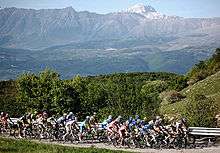
Most of the stages in the race are usually mass-start stages, with the whole peloton starting together.[45] Mass-start stages begin in different towns with a send off to gain publicity, the riders ride without racing.[45] The riders then ride a few kilometers around the stage's start town before reaching kilometer zero, where the race director then waves a flag to start the stage's racing.[45] Once the flag is waved there are usually attacks by the riders to form a breakaway.
Riders are permitted to touch, but not push or nudge, each other. The first to cross the line wins. On flat stages or stages with low hills, which generally predominate in the first week, this leads to spectacular mass sprints.
All riders in a group finish in the same time as the lead rider, which helps avoid dangerous mass sprints.[45] It is not unusual for the entire field to finish in a group, taking time to cross the line but being credited with the same time. When riders fall or crash within the final 3 kilometers of a stage with a flat finish, they were awarded the same time as the group they were in before they crashed.[45] This change encourages riders to sprint to the finish for points awards without fear of losing time to the group. The final kilometer of racing is indicated by a red banner on an arch that also reads "Arrivo."[45]
Time bonuses were awarded in the Giro for finishing high in the stages, in the first three positions. The stage's first placed rider receives twenty seconds, second placed twelve seconds, and the third placed rider receives six seconds.[45]
Mountains stages
The Giro d'Italia is known for its steep and difficult climbs. Each race features a few stages that contain many climbs of high severity. The race traditionally passes through the Alps with some of the longest climbs in the Dolomites. The first Alpine pass included was the Sestriere in 1911.[62] The Dolomites were first included in the Giro in 1937, when the race crossed over the Rolle Pass and the Passo di Costalunga.[63][64] Some of the most famous mountains used in the Giro are the Passo dello Stelvio,[65] Passo Pordoi, and the Passo di Gavia. Since 1965 the highest point in the Giro d'Italia has been dubbed the Cima Coppi in honor of the great Italian climber Fausto Coppi.[66]
Stages in the mountains often cause major shifts in the general classification. On ordinary stages, most riders stay in the peloton to the finish; however during mountain stages, it is not uncommon for riders to lose 30 minutes or to be eliminated after finishing outside the time limit.[45]
Individual time trials
Riders in a time trial compete individually against the clock.[45][59] If the first stage of the Giro is a time trial, then order is determined by a draw to establish the team's sequence.[45] Once the team's order is chosen, then the teams can choose the starting order.[45] If the incumbent winner of the Giro d'Italia is participating, he will start last.[45] The riders are given staggered start times between one and three minutes.[45] Once the first stage has been run and the general classification standing has been established, the riders' start order is determined by the inverse standings of the general classification, with the highest ranked person going last and the lowest ranked person going first.[45] The first time trial was in the 1933 Giro d'Italia; it was between Bologna and Ferrara, and stretched 62 km (39 mi).[46] The first time trial was won by Alfredo Binda.[46]
The first stage in modern Giros is often a short trial, a prologue, to decide who wears pink on the opening day. To be classified as a prologue, the time trial must be shorter than 8 km (5 mi) in length.[58][59] The first prologue occurred in the 1968 Giro d'Italia.[67] The route stretched 5.7 km (4 mi) around the streets of Campione d'Italia and was won by the Frenchman Charly Grosskost.[67] The riders raced the course in an unusual format, with the riders racing in ten groups of thirteen and the time not being counted towards their overall time.[67]
There are usually two or three time trials, with team time trials being included in the tally, in each modern edition of the Giro d'Italia. The final time trial has sometimes been the final stage, more recently often the penultimate stage.
Team time trial
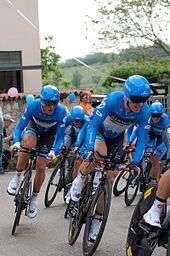
A team time trial (TTT) is a race against the clock in which each team rides alone.[59] The order for the team time trial is determined by the inversed order of the team classification, except for the race leader's team who is always the last to start.[45] The teams' start times are staggered by five minutes.[45][59] The riders work together in the team time trial by taking turns at the front, to lift the pace and break the wind for their teammates to save them energy.[59] The time is that of the fifth rider of each team: riders more than a bike-length behind their team's fifth rider were awarded their own times.[45][59] The TTT has been criticized for favoring strong teams and handicapping strong riders in weak teams. The most recent team time trial in the Giro was in the 2015 edition, which was won by Orica–GreenEDGE.[68]
The team time trial has been used 20 times in the history of the in the Giro d'Italia.[69][70] The first team time trial occurred in the 1937 Giro d'Italia.[64] and was won by the Italian team, Legnano.[64][70][71] The course was 60 km (37 mi) in length and stretched from Viareggio to Marina di Massa.[64][71]
Stage towns
Each stage begins and ends in a city. Most stages have different start cities and end cities, while some stages have the same starting and ending location. Milan has hosted the most stage starts and finishes with 137 since the race traditionally finishes in Milan. In addition to that, the race used to begin in Milan during the race's early existence. Milan has hosted the most starts and finishes for Giro d'Italia stages, with Rome being a close second and many towns having hosted over 25 stages.[60]
The start and finish of the Giro
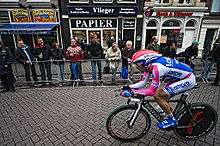
The start of the Giro d'Italia is a significant occasion and cities pay lots of money to host the start or finish of a stage.[72] For the start of the Giro itself, the cities are willing to pay much more money.[72] The money the city and other investors put into get the start is quickly earned back.[72] Former race director said that the cities often earn ten times the money they invested.[72]
For nearly half a century, the Giro started and finished by Milan, the city where the headquarters of the Gazzetta dello Sport were located.[73][74] The first time the race didn't start or finish in Milan was in 1911, where the start and finish were moved to Rome to celebrate the 50th anniversary of Italy's unification.[62] With the occasional exception, the start and finish in Milan was the standard for the Giro d'Italia. However, since 1960 the place of departure has changed each year. Some years (1965, 1966, 1968, 1970, 1973, 1975, 1981–1989) the finish was also changed, but in 1990 the traditional finish in Milan was restored.[75]
In 2009, to commemorate the centennial of the event, the finish took place in Rome.[76][77] The Italian capital, Rome, had already been the location of the final stage of the 1911 and 1950 editions of the Giro d'Italia.[62][78] The 2010 edition ended in Verona, as happened in the 1981 and 1984 editions.[79]
The Giro takes place mainly in Italy, but some stages have departure or conclusion locations in other countries, especially in neighboring countries such as San Marino, France, Monaco, Switzerland, Austria, Croatia and Slovenia.[80][81] Some stages have been held in the Netherlands, Belgium, Germany (2002 and 2006), Greece (1996)[80] and Denmark (2012)[80][82] The 2014 edition of the Giro started in Belfast.
Starts outside Italy
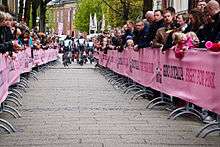
For the first 47 editions of the race, the race started on Italian soil. In 1965 the race made its first foreign start in San Marino, and has since had ten more foreign starts.[72][83] The most recent start outside Italy was in 2016 when the race started in Apeldoorn.
| Year | Country | City | Ref(s). |
|---|---|---|---|
| 1965 | |
[81][85] | |
| 1966 | |
Monte Carlo | [81][85] |
| 1973 | |
Verviers | [81][85] |
| 1974 | |
[81][85] | |
| 1996 | |
Athens | [81][85] |
| 1998 | |
Nice | [81][85] |
| 2002 | |
Groningen | [85] |
| 2006 | |
Seraing | [85] |
| 2010 | |
Amsterdam | [85] |
| 2012 | |
Herning | [45][85] |
| 2014 | |
Belfast | [85][86] |
| 2016 | |
Apeldoorn | [87][88] |
See also
References
- ↑ Juliet Macur (29 May 2015). "'Gironimo!' and 'Lanterne Rouge'". New York Times.
- ↑ Stephen Farrand (13 March 2016). "Nibali could skip Giro d'Italia due to risk of mountain stage cancellations". Cycling News.
- 1 2 3 4 5 6 7 8 9 10 11 12 13 Gregg Seltzer (26 May 2011). "The History of the Giro d'Italia.". Livestrong. Retrieved 30 July 2012.
- 1 2 3 "Tour d'Italie ou Giro d'Italia" [Tour of Italy or Giro d'Italia] (in French). Larousse.fr. 30 March 2012. Retrieved 10 August 2012.
- ↑ McGann, Bill; McGann, Carol. "1909 Giro d'Italia". Bike Race Info. Dog Ear Publishing. Retrieved 30 July 2012.
- ↑ "RCS Sport". RCSMediaGroup. RCS MediaGroup S.p.A. 24 January 2013. Retrieved 20 June 2013.
- ↑ "2012 - 2013 UCI Road Calendar". Union Cycliste Internationale. Union Cycliste Internationale. Retrieved 6 June 2013.
- ↑ Nigel Wynn (2 November 2011). "UCI WorldTour calendar 2012". Cycling Weekly. IPC Media Limited. Retrieved 6 August 2012.
- ↑ "Million dollar, baby!". Cycling News. Future Publishing Limited. 12 January 2007. Retrieved 21 May 2011.
- ↑ "Ryder Hesjedal in pink as Giro d'Italia hits the Alps". Perth Now. News Ltd. 20 May 2012. Retrieved 30 July 2012.
- 1 2 3 4 5 6 7 8 9 10 11 12 13 14 15 16 17 18 19 20 21 22 23 24 25 26 27 28 29 30 31 32 Laura Weislo (13 May 2008). "Giro d'Italia classifications demystified". Cycling News. Future Publishing Limited. Retrieved 27 August 2009.
- ↑ "Contador wins second title in Milan". 31 May 2015.
- 1 2 3 4 5 Fotheringham, William (30 June 2003). "The Heroic Age". Century of Cycling: The Classic Races and Legendary Champions. London, England, United Kingdom: MBI Publishing Company. pp. 103–104. ISBN 978-0-7603-1553-8. Retrieved 17 July 2012.
- 1 2 3 4 5 6 7 8 9 Bill and Carol McGann. "1909 Giro d'Italia". Bike Race Info. Dog Ear Publishing. Retrieved 10 July 2012.
- 1 2 3 4 5 6 7 8 9 10 11 12 13 14 15 16 17 18 19 20 21 22 23 "History". La Gazzetta dello Sport. RCS MediaGroup. Retrieved 15 September 2010.
- 1 2 Leslie Reissner (23 June 2011). "The Giro d'Italia: Don't Go Home Yet!". PezCycling News. Retrieved 27 May 2012.
- 1 2 "La Vuelta De Italia" [The Giro d'Italia] (PDF). El Mundo Deportivo (in Spanish). 10 June 1909. p. 3. Retrieved 27 May 2012.
- ↑ Castelnovi, Giuseppe (9 June 2001). "qual e' stato il giro d' italia piu' lungo, e quale il piu' breve ?". La Gazzetta dello Sport (in Italian). Retrieved 6 September 2010.
- ↑ "Giro d'Italia: In numbers". Eurosport. 6 May 2011. Retrieved 17 July 2011.
- ↑ Gallagher, Brendan (7 May 2009). "Giro d'Italia celebrates centenary year". The Daily Telegraph. London. Retrieved 4 September 2010.
- ↑ Stanley, Alessandra (6 May 2000). "Gino Bartali, 85, a Hero in Italy For His Cycling Championships". The New York Times. New York City. Retrieved 5 September 2010.
- ↑ Fotheringham 2010, p. 37
- 1 2 Henderson, Greg (15 May 2009). "50 Giro facts you need to know". Cycling News. Future Publishing Limited. Retrieved 5 September 2010.
- ↑ "Jacques Anquetil". The Daily Telegraph. London. 12 May 2010. Retrieved 17 July 2011.
- ↑ Sykes 2008, p. 35
- ↑ van Walleghem 1993, p. 73
- ↑ "Grand Tour Doubles – Bernard Hinault". Cycle Sport. IPC Media. Retrieved 17 July 2011.
- ↑ Doyle, Paul (5 July 2007). "Roche remembers his annus mirabilis". The Guardian. London. Retrieved 5 September 2010.
- ↑ Benson, Andrew (19 March 2004). "End of a troubled ride". BBC Sport. Retrieved 5 September 2010.
- ↑ Ekström, Gabriella (3 June 2000). "Stage 20 – June 3: Briancon to Sestrieres, (ITT) 34 km". Cycling News. Future Publishing Limited. Retrieved 5 September 2010.
- ↑ "Italian Di Luca fails doping test". BBC Sport. 22 July 2009. Retrieved 6 September 2010.
- ↑ "Menchov wins Giro despite crash". BBC Sport. 31 May 2009. Retrieved 6 September 2010.
- ↑ "Italy's Ivan Basso wins second Giro d'Italia title". BBC Sport. 30 May 2010. Retrieved 4 September 2010.
- ↑ "Alberto Contador wins 2011 Giro d'Italia". BBC Sport. 29 May 2011. Retrieved 29 May 2011.
- ↑ Fotheringham, William (6 February 2012). "Alberto Contsdor gets two-year ban and stripped of 2010 Tour de France". The Guardian. Retrieved 6 February 2012.
- ↑ "Giro d'Italia 2012: Ryder Hesjadel is first Canadian to win the race". BBC Sport. 27 May 2012. Retrieved 27 May 2012.
- ↑ Benson, Daniel (26 May 2013). "http://www.cyclingnews.com/giro-ditalia/stage-21/results". Cycling News. Future Publishing Limited. Retrieved 5 September 2010. External link in
|title=(help) - ↑ VeloNews.com (17 June 2005). "Happy Birthday, Eddy!". VeloNews. Competitor Group, Inc. Retrieved 23 June 2012.
- ↑ VeloNews.com (15 March 2012). "Giro d'Italia Hall of Fame inducts Eddy Merckx as its first member". VeloNews. Competitor Group, Inc. Retrieved 23 June 2012.
- ↑ "The Belgian Italians couldn't resist - Eddy Merckx". Cycling News. Future Publishing Limited. 28 May 2011. Retrieved 1 October 2012.
- 1 2 3 4 "Giro d'Italia 2009" (PDF). Infostrada sports. 2009. p. 187. Retrieved 29 June 2011.
- ↑ McGann, Bill; McGann, Carol. "1910 Giro d'Italia". Bike Race Info. Dog Ear Publishing. Retrieved 6 August 2012.
- 1 2 McGann, Bill; McGann, Carol. "1913 Giro d'Italia". Bike Race Info. Dog Ear Publishing. Retrieved 6 August 2012.
- ↑ McGann, Bill; McGann, Carol. "1914 Giro d'Italia". Bike Race Info. Dog Ear Publishing. Retrieved 6 August 2012.
- 1 2 3 4 5 6 7 8 9 10 11 12 13 14 15 16 17 18 19 20 21 22 23 24 25 26 "Formula and Itinerary" (PDF). Gazzetta della Sport. 2012. pp. 6–7. Retrieved 29 June 2012.
|section=ignored (help) - 1 2 3 McGann, Bill; McGann, Carol. "1933 Giro d'Italia". Bike Race Info. Dog Ear Publishing. Retrieved 6 August 2012.
- ↑ Cycling News (17 December 2011). "Blue Mountains Jersey For 2012 Giro D'Italia". Cycling News. Future Publishing Limited. Retrieved 20 June 2013.
- ↑ http://www.cyclingupdates.com/giro-ditalia-2015-preview-the-mountain-classification/. Missing or empty
|title=(help) - ↑ McGann, Bill; McGann, Carol. "1966 Giro d'Italia". Bike Race Info. Dog Ear Publishing. Retrieved 6 August 2012.
- ↑ Cycling News (15 January 2010). "2010 Giro jersey presented in Florence". Cycling News. Future Publishing Limited. Archived from the original on 18 January 2010. Retrieved 20 June 2013.
- 1 2 3 4 5 6 Gregor Brown (4 December 2006). "First Edition Cycling News for December 4, 2006". Cycling News. Future Publishing Limited. Retrieved 30 July 2012.
- 1 2 3 "Giro, la Maglia nera diventa Numero nero" [The Giro, the black jersey becomes the black number]. La Gazzetta dello Sport (in Italian). Milan, Italy: RCS MediaGroup. 11 January 2008. Retrieved 4 August 2012.
- 1 2 3 "91st Giro d'Italia – GT". Cycling News. Future Publishing Limited. 1 June 2008. Retrieved 20 June 2013.
- ↑ "Giro d'Italia, Intergiro-Wertung". Radsport-seite.de. Retrieved 4 August 2012.
- ↑ "Hinault: Tres Vidas En Rosa" [Hinault: Three Lives In Pink] (PDF). El Mundo Deportivo (in Spanish). 10 June 1985. p. 34. Retrieved 27 May 2012.
- ↑ Richard Pestes (1 December 2007). "Giro 1988: Andy's Epic Day". PezCycling News. Retrieved 27 May 2012.
- ↑ Anthony Tan (28 May 2006). ""Seven key moments"; Mission 1 of 2 complete". Cycling News. Future Publishing Limited. Retrieved 20 June 2013.
- 1 2 "UCI Cycling Regulations, Part II: Road Races". UCI. 1 February 2012: 40
- 1 2 3 4 5 6 7 8 9 "Tour de France: Time Trials, Mountains Stages, Prologues, and More – For Dummies". Dummies.com. 2008-11-07. Retrieved 6 August 2012.
- 1 2 "Giro d'Italia – Giro d'Italia: In numbers". Eurosport. Yahoo! and Eurosport. 6 May 2011. Retrieved 13 August 2011.
- ↑ Fabio (9 November 2003). "87th Giro d'Italia: a bit of History". dailypeloton.com. Retrieved 29 October 2007.
- 1 2 3 McGann, Bill; McGann, Carol. "1911 Giro d'Italia". Bike Race Info. Dog Ear Publishing. Retrieved 6 August 2012.
- ↑ "Le Giro a 100 ans" [The Giro d'Italia is 100 Years Old]. larousse.fr (in French). Retrieved 16 September 2010.
- 1 2 3 4 McGann, Bill; McGann, Carol. "1937 Giro d'Italia". Bike Race Info. Dog Ear Publishing. Retrieved 6 August 2012.
- ↑ Daniel Friebe (25 May 2012). "The Stelvio: The sacred mountain of the Giro d'Italia". Cycling News. Future Publishing Limited. Retrieved 30 July 2012.
- ↑ McGann, Bill; McGann, Carol. "1965 Giro d'Italia". Bike Race Info. Dog Ear Publishing. Retrieved 6 August 2012.
- 1 2 3 McGann, Bill; McGann, Carol. "1968 Giro d'Italia". Bike Race Info. Dog Ear Publishing. Retrieved 6 August 2012.
- ↑ Ian Chadband (5 May 2013). "Giro d'Italia 2013, stage two: Team Sky storm to victory in team time-trial as Salvatore Puccio takes maglia rosa". The Daily Telegraph. London: Telegraph Media Group Limited. Retrieved 4 August 2012.
- ↑ "Giro d'Italia 2010 – 4th stage – Liquigas-Doimo wins the team time trial, Vincenzo Nibali takes the maglia rosa". velowire.com. 12 May 2012. Retrieved 6 August 2012.
- 1 2 Gregor Brown (9 May 2012). "Teams are ready for Giro's team time trial". Cycling Weekly. IPC Media Limited. Retrieved 6 August 2012.
- 1 2 Jean-François Quénet (9 May 2012). "Farrar Only 10 Seconds Away From The Giro's Pink Jersey". Cycling News. Future Publishing Limited. Retrieved 6 August 2012.
- 1 2 3 4 5 6 Gregor Brown (15 December 2012). "Foreign grand tour starts are big business". VeloNews. Competitor Group, Inc. Retrieved 23 June 2012.
- ↑ "Giro d'Italia". Milan Tourism. Milano City. 5 May 2012. Retrieved 10 August 2012.
- ↑ "May 27, Stage 21: Milan (ITT) 31.5km". Cycling News. Future Publishing Limited. Retrieved 19 July 2012.
- ↑ Sheree (12 May 2012). "Friday Feature: Giro d'Italia starts on foreign soil". Velo Voices. Retrieved 6 August 2012.
- ↑ "Stages". La Gazzetta dello Sport (in Italian). RCS MediaGroup. Archived from the original on 18 February 2009. Retrieved 20 June 2013.
- ↑ "Stage 21 – Sunday, May 31: Roma (ITT), 14.4km". Cycling News. Future Publishing Limited. 9 May 2009. Retrieved 9 May 2009.
- ↑ McGann, Bill; McGann, Carol. "1951 Giro d'Italia". Bike Race Info. Dog Ear Publishing. Retrieved 6 August 2012.
- ↑ Gregor Brown (24 October 2009). "Zomegnan Presents An All-inclusive 2010 Giro D'Italia". Cycling News. Future Publishing Limited. Retrieved 19 August 2012.
- 1 2 3 "2012 Giro d'Italia Start: to Denmark!". Bianchi USA. 1 April 2011. Retrieved 6 August 2012.
- 1 2 3 4 5 6 7 Fabio. "Giro d'Italia Stage Detail". Daily Peloton. Retrieved 6 August 2012.
- ↑ VeloNews.com (24 May 2010). "2012 Giro d'Italia to start in Denmark, not Washington, D.C.". VeloNews. Competitor Group, Inc. Retrieved 1 April 2011.
- ↑ Alasdair Fotheringham (5 May 2012). "The Most International Giro D'Italia Ever?". Cycling News. Future Publishing Limited. Retrieved 20 August 2012.
- ↑ Luca Gialanella (11 April 2011). "Il Giro è sempre più globale Nel 2012 il via dalla Danimarca" [The Giro is increasingly global in 2012 by Denmark]. La Gazzetta dello Sport (in Italian). RCS MediaGroup. Retrieved 10 July 2012.
- 1 2 3 4 5 6 7 8 9 10 11 Cycling News (21 February 2013). "Giro d'Italia confirmed start in Ireland for 2014". Cycling News. Future Publishing Limited. Retrieved 21 February 2013.
- ↑ "Giro to start in Ireland in 2014". ESPN. Associated Press. 21 February 2013. Retrieved 21 February 2013.
- ↑ "Giro 2016 start in Nederland". NOS. NOS. 26 May 2014. Retrieved 26 May 2014.
- ↑ "Giro d'Italia 2016". La Gazetta. 26 June 2015. Retrieved 28 June 2015.
External links
| Wikimedia Commons has media related to Giro d'Italia. |
- Official website
- Giro d'Italia Palmares at Cycling Archives